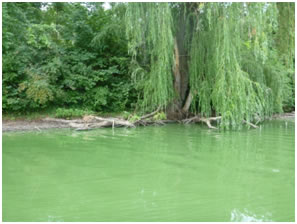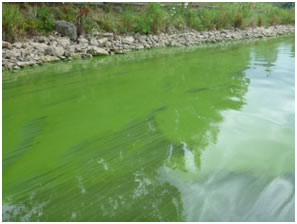Dog Succumbs to Algal Bloom Toxins

Blue-green algae, such as that affecting the water above, can be deadly to dogs and other pets. Photo credit: Illinois Environmental Protection Agency. Accessed 2014.
In a June 26, 2014, report, KMSP-TV (Minneapolis-St Paul) described the tragedy a Minnesota family encountered in a seemingly benign setting. The Tatge family was enjoying a Sunday afternoon at a Minnesota lake with their faithful canine companion, Copper. Copper had ventured into Prairie Lake to play one of his favorite games, fetching a tennis ball. The lake was teeming with blue-green algae, and unbeknownst to the family, some of the algae was toxic.
Blue-Green Algae Can Be Toxic to Your Dog
Blue-green algae can produce toxins in high enough levels to be toxic to humans and pets. People or pets can become ill by by coming into contact with toxin-contaminated water, either through direct skin contact or exposure to airborne droplets (Illinois EPA). Dogs may become ill by licking their fur after being exposed to toxin-contaminated water, and thus can ingest the bacterial toxins this way (Ecology). This is likely how the Tatge’s family dog Copper was exposed. Because of their relatively low body weights, children and small animals, such as small dog breeds, are especially vulnerable to illness from toxin exposure.
Blue-green algae produce two types of toxin: a hepatotoxin, which affects the liver, and a neurotoxin, which affects the central nervous system (Ecology). The hepatotoxins, Microcystins, are the most common toxins produced by blue-green algae, but the neurotoxin, Anatoxin A, can also cause serious or lethal symptoms. If you think your dogs has been exposed, monitor carefully for the symptoms listed in the chart below (Source: Pet MD).
| Seek Immediate Veterinary Attention If Your Dog has Any of These Symptoms |
|
Symptoms of Hepatotoxin Exposure
|
Symptoms of Neurotoxin Exposure
|
| Source: Pet MD | |
What is an Algal Bloom?
Algal bloom is simply rapid, seemingly explosive, growth of algae. Warmer temperatures during summer months catalyze rapid algae growth in surface waters, especially when those waters are contaminated with fertilizer-laden runoff. This phenomenon has been termed an “algal bloom.” Most algal blooms are innocuous, and pose no threat to humans or pets. In fact, even among blue-green algae specioes, the source of the toxins that led to Copper’s death, only certain types of blue-green algae produce toxins and then only at certain times. In addition to the temperature and nutrient sources, heavy rains and low lake levels also increase the chances of an algal bloom.
What is Blue-Green Algae?
Blue-green algae, or cyanobacteria as it is more formally known, is actually a misnomer. Unlike other algae, which are plants, blue-green algae is a type of bacterium. Blue-green algae is found anywhere there is water, with habitats including lakes, rivers, glaciers, and soil (Stoyanov, et. al.). In fact, it can grow with as little moisture as what can be found on desert rocks.
The term “blue-green algae” actually refers many different species of cyanobacteria, but only some species of blue-green algae are toxic. However, if you suspect a blue-green algae bloom, do not go into the water or allow children or pets near. See pictures at the top of the post and below for examples of blue-green algae bloom.

“Surface water affected by blue-green algae often is strongly colored such that it can develop a paint-like appearance.” Photo credit: Illinois Environmental Protection Agency.
What to do if Your Pet is Exposed
If you think someone (human, dog, or other pet) has come into contact with blue-green algae, don’t panic. Illness may be avoided if you take the following steps:
- Don’t allow your dog to lick its fur. This is one of the most common routes of exposure for dogs.
- Wash the affected area with copious amounts of soap and water. Washing away the toxins will prevent your dog from licking its fur and being exposed. Take reasonable precautions, such as using rubber gloves and avoiding contact with the algae as much as possible. Wash your hands after you handle blue-green algae and launder contaminated clothing. Shower if you suspect blue-green algae has contacted your skin.
- Call your doctor, veterinarian, or poison control (see below for animal point control numbers) for further instructions.
ASPCA Animal Poison Control Hotline
1-(888) 426-4435
A fee may apply - If you are still at the lake or river where you suspect the exposure occurred, snap a picture of the bloom. This may aid your veterinarian in diagnosis. If your pet is showing symptoms of a hepatotoxin or a neurotoxin, but the “pond scum” you saw was not blue-green algae, you will be able to move on to more likely suspects for the cause of your dog’s symptoms.
References
Plamen Stoyanov, Dzhemal Moten, Rumen Mladenov, Balik Dzhambazov, and Ivanka Teneva. Phylogenetic Relationships of Some Filamentous Cyanoprokaryotic Species. Evol Bioinform Online. 2014; 10: 39–49.
Illinois EPA (Illinois Environmental Protection Agency). Blue-Green Algae and Algal Toxins. Accessed 2014.
Ecology (Department of Ecology, State of Washington). Algae Control Program. Accessed 2014.
Pet MD. Blue-Green Algae: Is it Poisonous to Dogs? Accessed 2014.







2 comments
Andrew
August 26, 2014 at 9:02 am (UTC 0) Link to this comment
Explosive growth of algae induces greater amount of toxin into the water. The contaminated water can sometimes become hazardous for humans and pets. So, the only way to stay out of situations like these is to eradicate algae from lakes and get it cleaned.
Jana
September 10, 2014 at 6:30 am (UTC 0) Link to this comment
Thanks for your comment! It might be difficult to totally eradicate this algae. That’s why it’s important to be aware and avoid lakes and streams during an algae bloom.